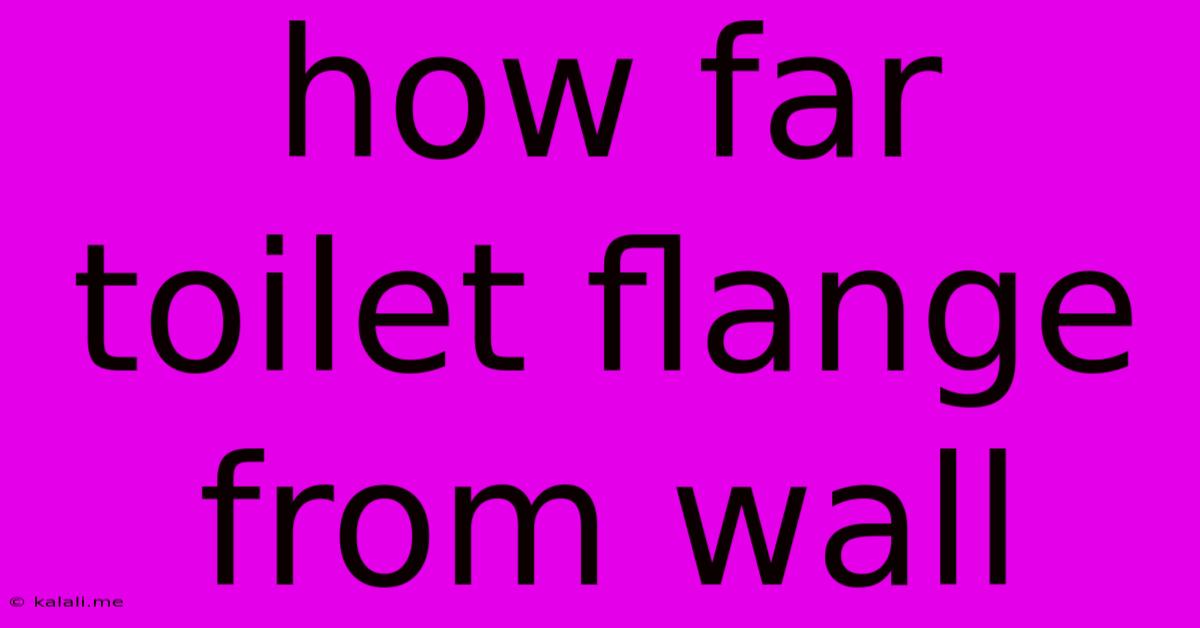How Far Toilet Flange From Wall
Kalali
Jun 10, 2025 · 3 min read

Table of Contents
How Far Should a Toilet Flange Be From the Wall? A Comprehensive Guide
Determining the correct distance of your toilet flange from the wall is crucial for a proper and leak-free toilet installation. Getting this wrong can lead to wobbly toilets, difficult-to-clean areas, and even costly plumbing repairs down the line. This guide will help you understand the ideal placement and troubleshooting common issues.
What is a Toilet Flange? The toilet flange is the metal ring bolted to the floor that your toilet bolts onto. It connects your toilet to the drainpipe, creating a watertight seal. Its placement is fundamental to the stability and functionality of your toilet.
Ideal Distance: The Goldilocks Zone
There's no single universally prescribed distance. The ideal distance depends on several factors including your specific toilet model, the type of flooring, and the existing plumbing. However, a good rule of thumb is to aim for 12 to 15 inches between the center of the toilet flange and the wall. This provides enough clearance for the toilet base and prevents it from being too close to the wall, potentially making cleaning difficult.
Factors Influencing Flange Placement:
- Toilet Size and Design: Different toilets have varying base sizes and projections. Check your toilet's installation instructions for specific recommendations. Larger toilets may need slightly more distance from the wall.
- Wall Type: The type of wall (drywall, plaster, brick) and its thickness doesn't directly affect flange placement but may influence the overall bathroom layout.
- Existing Plumbing: If you are replacing a toilet, the existing flange location might already be set. In this case, assess if it's correctly placed. If not, you might consider relocating it before installing the new toilet, as this can be significantly easier than fixing it later.
- Personal Preference: While you should strive for the optimal range, slight adjustments might be acceptable based on your bathroom layout and personal preferences, provided the functionality of the toilet isn't compromised.
Troubleshooting Issues with Flange Placement:
- Flange Too Close to the Wall: This can result in a wobbly toilet, difficulties in cleaning behind the toilet, and potential strain on the bolts. If the flange is too close, replacing it or repositioning the existing plumbing is the most effective solution. This often requires professional plumbing skills.
- Flange Too Far From the Wall: Although less common than the previous issue, a flange that is too far from the wall can create an awkward and visually unappealing installation, making the toilet seem too far from the wall, but usually poses less of a functional problem.
- Flange Offset: Sometimes the flange may not be perfectly centered on the drainpipe. This can lead to an unevenly seated toilet. Again, a plumber should address this issue.
Before You Start: Always turn off the water supply before beginning any work related to your toilet. If you are not confident in your plumbing abilities, it's always best to consult a qualified plumber for toilet installation or relocation.
Conclusion:
While the optimal distance of a toilet flange from the wall usually falls within 12 to 15 inches, various factors can influence the ideal placement. By carefully considering the toilet's size, existing plumbing, and personal preferences, you can ensure a stable, functional, and aesthetically pleasing installation. Remember that accuracy during this stage significantly impacts the overall toilet installation success. If you encounter any issues, consult a qualified plumber to avoid damaging your plumbing and ensuring a proper toilet installation.
Latest Posts
Latest Posts
-
Meaning Of In The Capacity Of
Jun 10, 2025
-
What Is The Red Wire In Electrical
Jun 10, 2025
-
How To Implement A Soft Render
Jun 10, 2025
-
How To File The Edges Of Plastic Laminate
Jun 10, 2025
-
Closed Dot On Peicewise Function Meaning
Jun 10, 2025
Related Post
Thank you for visiting our website which covers about How Far Toilet Flange From Wall . We hope the information provided has been useful to you. Feel free to contact us if you have any questions or need further assistance. See you next time and don't miss to bookmark.